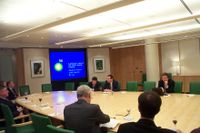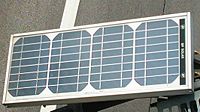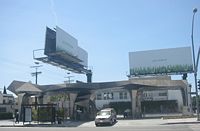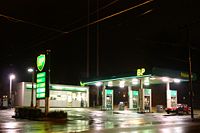BP
2008/9 Schools Wikipedia Selection. Related subjects: Companies
| BP plc | |
|---|---|
 |
|
| Type | Public (LSE: BP, NYSE: BP, TSX: BP.U) |
| Founded | 1908 (as the Anglo-Persian Oil Company) 1954 (as The British Petroleum Company) |
| Headquarters | London, England, UK |
| Key people | Donald Alexander Smith (founding chairman) Tony Hayward, CEO Byron Grote, CFO |
| Industry | Oil and Natural Gas, Alternative fuel |
| Products | BP petroleum and derived products BP service stations Air BP Aviation Fuels Castrol motor oil ARCO gas stations am/pm convenience stores Aral service stations |
| Revenue | ▲$274.316 Billion USD ( 2006) |
| Operating income | ▲ $35.158 Billion USD ( 2006) |
| Net income | ▲ $22.286 Billion USD ( 2006) |
| Employees | 115,000 ( 2006) |
| Website | www.bp.com |
BP plc (LSE: BP, NYSE: BP, TYO: 5051, TSX: BP.U), formerly known as British Petroleum, is a British energy company / multinational oil company (" oil major") with headquarters in London, England, UK. The company is among the largest private sector energy corporations in the world, and one of the six " supermajors" ( vertically integrated private sector oil exploration, natural gas, and petroleum product marketing companies).
Origins and history
Activity in 1909 - 1979
In May 1901, William Knox D'Arcy was granted a concession by the Shah of Iran to search for oil which he found in May 1908. This was the first commercially significant find in the Middle East. On 14 April 1909, the Anglo-Persian Oil Company (APOC) was incorporated to exploit this. In 1935, it became the Anglo-Iranian Oil Company (AIOC).
After World War II, AIOC and the Iranian government initially resisted nationalist pressure to revise AIOC's concession terms still further in Iran's favour. But in March 1951, the pro-western Prime Minister Ali Razmara was assassinated. The Majlis of Iran (parliament) elected a nationalist, Mohammed Mossadeq, as prime minister. In April, the Majlis nationalized the oil industry by unanimous vote. The British government contested the nationalization at the International Court of Justice at The Hague, but its complaint was dismissed.
The British government decided that the only way to regain its control of Iranian oil (which it regarded as a vital national interest), was to remove Mossadeq from office. It aimed to replace him with a more friendly regime led by the Shah, Mohammed Reza Pahlavi. Its problem was that it lacked the means to do so without American support. But it was clear the U.S. government would never support a coup d'état designed only to protect Britain's commercial interests. So the British played on America's then paranoia about the Communist "threat" by producing bogus "evidence" that Mossadeq was scheming to bring Iran into the Soviet sphere of influence. In early 1953, incoming U.S. President Dwight D. Eisenhower authorized the Central Intelligence Agency (CIA) to overthrow the Iranian government. The CIA conspiracy, involving the Shah and the Iranian military, became known by its codename, " Operation Ajax".
On August 19, 1953, Mossadeq was forced from office by a military coup. He was replaced by pro-Western general Fazlollah Zahedi. The Shah, who had left the country briefly to await the outcome of the coup, returned to Iran. He abolished the democratic Constitution and assumed autocratic powers. The AIOC became the British Petroleum Company in 1954, and resumed operations in Iran. However, it was not allowed to monopolize Iranian oil as before. It was limited to a 40% share in a new international consortium.
BP continued to operate in Iran until the Islamic Revolution in 1979. The new regime of Ayatollah Khomeini confiscated all of BP's assets in Iran without compensation, finally closing BP's 70-year presence in Iran. However, due to its huge investments outside Iran, especially in the North Sea and Alaska, the company's status as an oil major survived its Iranian disaster.
1960s and 1970s
From the late 1960s the company expanded beyond the Middle East to the USA ( Prudhoe Bay, Alaska) and the North Sea. Both of these fields came on stream in the mid-1970s. In 1969, BP acquired the Valdez oil terminal, Alaska, from the Chugach for $1. Some natives contend that this was an illegal transfer.
In the mid-1970s, BP acquired Standard Oil of Ohio or Sohio, a breakoff of the former Standard Oil that had been broken up after anti-trust litigation.
1980s and 1990s
P.I. Walters (later Sir Peter Walters) was BP's chairman from 1981 to 1989. This was the era of the Thatcher government's privatisation strategy. The British government sold its entire holding in BP in several tranches in 1984-7. The sale process was marked by an attempt by the Kuwait Investment Office, the investment arm of the Kuwait government, to acquire control of BP. This was ultimately blocked by the strong opposition of the British government. In 1987, British Petroleum negotiated the acquisition of Britoil and those shares of Standard Oil of Ohio (Sohio) through CEO Charlie Spahr not already owned.
Walters was replaced by Sir Robert Horton in 1989. Horton carried out a major corporate downsizing exercise, making over 1,000 head office bureaucrats redundant. He moved head office from its multi-storey office block in Moorgate to an older building that BP had previously occupied in Finsbury Square, also in the City of London.
Lord Browne of Madingley, who had been on the board as managing director since 1991, was appointed group chief executive in 1995. Browne was responsible for three major acquisitions; Amoco, ARCO and Burmah-Castrol (see below). This turned BP into the second largest independent oil company in the world.
Recent years
British Petroleum merged with Amoco (formerly Standard Oil of Indiana), in December 1998, becoming BPAmoco until 2000, when it was renamed BP and adopted the tagline "Beyond Petroleum," which remains in use today. It states that BP was never meant to be an abbreviation of its tagline. Most Amoco gas stations in the United States have changed the look and name to the BP brand. In many states, however, BP is selling Amoco branded gasoline, as it was rated the #1 petroleum brand by consumers 16 years in a row (the name of the service station itself is still BP) and Amoco has one of the highest brand loyalty for gasoline in the US with only Chevron and Shell having such high rates as BP/Amoco. In 2000, British Petroleum acquired Arco (Atlantic Richfield Co.) and Burmah Castrol plc.
In April of 2004, BP decided to move most of its petrochemical businesses into a separate entity called Innovene within the BP Group. Their intention was to sell the new company possibly via an Initial Public Offering (IPO) in the US, and in fact they filed their IPO plans for Innovene with the New York Stock Exchange on September 12, 2005. However, on October 7, 2005, BP announced that they had agreed to sell Innovene to INEOS, a privately held UK chemical company for the sum of $9 billion, thereby scrapping their plans for the IPO.
On March 23, 2005, an explosion occurred at BP's Texas City Refinery in Texas City, Texas. It is the third largest refinery in the United States and one of the largest in the world, processing 433,000 barrels of crude oil per day and accounting for 3% of that nation's gasoline supply. Over 100 were injured, and 15 were confirmed dead, including employees of the Fluor Corporation as well as BP. BP has since accepted that its mismanagement contributed to the accident. Level indicators failed, leading to overfilling of a heater, and light hydrocarbons spread throughout the area. An unidentified ignition source set off the explosion.
In 2005, BP announced it would be leaving the Colorado market. Many locations were rebranded as Conoco.
According to some private BP-branded gasoline centre operators in the Metro Atlanta area, BP plans to leave the Southern market in the next few years. All corporate-owned BP stations, typically known as "BP Connect" will be sold to local jobbers.
In March 2006, a leak in one of BP's pipelines on the North Slope of Alaska caused a spill of oil onto the tundra, leading BP to commit to replace over 16 miles of federally regulated Oil Transit Lines (OTLs). As of the end of 2007, one half of the pipeline had been replaced and all 16 miles of pipeline are now tested regularly.
BP has recently looked to grow its oil exploration activities in frontier areas like the former Soviet Union for its future reserves. In Russia, BP owns 50% of TNK-BP with the other half owned by three Russian billionaires. TNK-BP accounts for a fifth of BP's global reserves, a quarter of BP's production, and nearly a tenth of its global profits.
On July 19, 2006, BP announced that it would close the last 12 out of 57 oil wells in Alaska, mostly in Prudhoe Bay, that had been leaking. The wells were leaking insulating agent called Arctic pack, consisting of crude oil and diesel fuel, between the wells and ice.
On 12 January 2007, it was announced that Lord Browne would retire at the end of July 2007. The new Chief Executive will be the current head of exploration and production, Tony Hayward. It had been expected that Lord Browne would retire in February 2008 when he reached the age of 60, the standard retirement age at BP. Browne resigned abruptly from BP on 1 May 2007, following the lifting of a legal injunction preventing Associated Newspapers from publishing details about his private life. Hayward succeeded Browne with immediate effect.
As of February 11, 2007 BP announced that they would spend 8 billion dollars over ten years to research other methods of fuel.
Financial data
| Year | 2002 | 2003 | 2004 | 2005 | 2006 |
|---|---|---|---|---|---|
| Sales | 180 186 | 236 045 | 294 849 | 249 465 | 265 906 |
| EBITDA | 22 941 | 28 200 | 37 825 | 41 453 | 44 835 |
| Net Results | 6 845 | 10 267 | 15 961 | 22 341 | 22 000 |
| Net Debt | 20 273 | 20 193 | 21 607 | 16 202 | 16 202 |
-
-
-
-
-
- Source :' OpesC'
-
-
-
-
Corporate controversies
August 2006 Prudhoe Bay shutdown
As of August 7, 2006, BP has begun to shutdown oil operations in Prudhoe Bay, Alaska, due to corrosion in the pipeline. BP had spilled over one million litres of oil in Alaska's North Slope. This corrosion is caused by sediment collecting in the bottom of the pipe, protecting corrosive bacteria from chemicals sent through the pipeline to fight this bacteria. Prudhoe Bay produces about 2.6% of the United States demand for gasoline. It was initially estimated that the shutdown would cause a reduction of 400,000 barrels per day and reaction to that scenario was a contributing factor increasing the price of oil $1 to over $77(USD) per barrel. To, date 1,513 barrels of liquids, about 5,200 cubic yards of soiled snow and 328 cubic yards of soiled gravel have been recovered. There are estimates that about 5,000 barrels of oil were released from the pipeline. After further analysis and approval from the DOT, only the eastern portion of the field was shut down which resulted in a reduction of 200,000 barrels per day until work began to bring the eastern field to full production on October 2. In May 2007, the company announced yet a further shutdown of the Prudhoe Bay pipeline owing to leaks of water at a separation plant. Their action was interpreted as another example of fallout from a decision to cut maintenance of the pipeline and associated facilities.
October 2007 Prudhoe Bay spill
On October 16, 2007 Alaska Department of Environmental Conservation officials reported a toxic spill of methanol at the Prudhoe Bay oil field managed by BP PLC. Nearly 2,000 gallons of mostly methanol, mixed with some crude oil and water, spilled onto a frozen tundra pond and a gravel pad from a pipeline. Methanol, which is poisonous to plants and animals, is used to clear ice from the insides of the Arctic-based pipelines.
Lake Michigan Plant expansion
In July 2007, the Chicago Tribune reported that BP will be permitted to pollute Lake Michigan with an average of 1,584 pounds of ammonia and 4,925 pounds of sludge -- every day -- from its Whiting, Indiana oil plant outside of Chicago. BP responded to the media coverage, indicating that no sludge or toxic waste will be discharged to the lake. Instead, the permit allows a higher daily limit to the discharge of total suspended solids. The increase in ammonia and solids is due to a plant expansion that will allow it to accept Canadian crude oil as opposed to Middle Eastern crude. The output of the refinery is well below the maximum permitted under federal guidelines. With this action, the state of Indiana and EPA authorities allowed BP to be exempted from following all provisions of the federal Clean Water Act, and more specifically, the "antibacksliding" provisions within the act designed to prevent a company from ever increasing its water pollution levels, regardless of other limits or factors.
On August 17, 2007, the Chicago Sun-Times urged readers to boycott BP gas stations: "At this point, the only clear message BP is sending is that it wants to have its cake and eat it too. BP executives want their company to be known as the greenest -- as suggested by its logo, meant to resemble a sunflower and show its commitment to the environment. But they also want to dump in our lakes. They can't have it both ways...That's why we have to help them decide which road they'll choose by hitting their pocketbooks -- at least until September 1 when they'll return to Chicago to give Emanuel and Sen. Dick Durbin (D-Ill.) an update on their plans."
Recently, BP has announced it will put the plant expansion under review. Bob Malone, BP America President, cited both environmental and financial concerns when announcing that they may seek alternatives to the controversial Whiting expansion. It is unclear what impact this will have on the stated policy of making the United States less dependent on foreign oil.
Environmental record
BP was named one of the "ten worst corporations" in both 2001 and 2006 based on its environmental and human rights records. In 1991 BP was cited as the most polluting company in the US based on EPA toxic release data. Since branding itself an environmentally sound corporation in 1997, BP has been charged with burning polluted gases at its Ohio refinery (for which it was fined $1.7 million), and in July 2000 BP paid a $10 million fine to the EPA for its management of its US refineries. According to PIRG research, between January 1997 and March 1998, BP was responsible for 104 oil spills.
BP Solar is a leading producer of solar panels since its purchase of Lucas Energy Systems in 1980 and Solarex (as part of its acquisition of Amoco) in 2000. BP Solar had a 20% world market share in photovoltaic panels in 2004 when it had a capacity to produce 90 MW/year of panels. It has over 30 years experience operating in over 160 countries with manufacturing facilities in the U.S., Spain, India and Australia and has more than 2000 employees worldwide.
BP/Amoco was a member of the Global Climate Coalition an industry organisation established to promote global warming skepticism but withdrew in 1997, saying "the time to consider the policy dimensions of climate change is not when the link between greenhouse gases and climate change is conclusively proven, but when the possibility cannot be discounted and is taken seriously by the society of which we are part. We in BP have reached that point.".
In February 2002 BP's chief executive, Lord Browne of Madingley, renounced the practice of corporate campaign contributions, noting: "That's why we've decided, as a global policy, that from now on we will make no political contributions from corporate funds anywhere in the world."
In March 2002 Lord Browne of Madingley declared in a speech that global warming was real and that urgent action was needed, saying that "Companies composed of highly skilled and trained people can't live in denial of mounting evidence gathered by hundreds of the most reputable scientists in the world.". In 2005 BP was considering testing carbon sequestration in one of its North Sea oil fields, by pumping carbon dioxide into them (and thereby also increasing yields).
In 2004, BP began marketing low-sulfur diesel fuel for industrial use. BP intends to create a network of hydrogen fueling stations in the state of California.
Accusations of "greenwashing"
British Petroleum changed its name to BP in 2000, and introduced a new corporate slogan: “Beyond Petroleum.” It replaced its “Green Shield” logo with the helios symbol, a green and yellow sunflower pattern similar to the emblem of the Green Party of Canada. These changes were intended to highlight the company’s interest in alternative and environmentally friendly fuels. When, in July of 2006, BP admitted, only after journalists became aware of the spill, that it was facing criminal charges for allowing 270,000 gallons of crude oil to spread into the Alaskan tundra, environmental advocates pointed to the relative lack of press coverage about the spill as evidence that BP had successfully "greenwashed" its image while maintaining environmentally unsound practices.
Texas City Refinery disaster
One of BP's largest refineries in the USA exploded in 2005 causing 15 deaths. The fall-out from the accident continues to cloud BP's corporate image because of the mismanagement at the plant. There have been several investigations of the disaster, the most recent being that from the U.S. Chemical Safety and Hazard Investigation Board. It was preceded by the Baker report and BP's own internal investigation.
A large column filled with gasoline overflowed to form a vapour cloud, which ignited. The explosion caused all the casualties and substantial damage to the rest of the plant. The incident came as the culmination of a series of less serious accidents at the refinery, and the engineering problems were not addressed by the management. Maintenance and safety at the plant had been cut as a cost-saving measure, the responsibility ultimately resting with executives in London. The disaster indirectly helped (with several other factors) bring about the premature resignation of Lord Browne, and will continue to affect the company for some time to come.
Other problems
However, BP's image has been tarnished somewhat by its involvement with the controversial Baku-Tbilisi-Ceyhan pipeline, criticized for human rights abuses, environmental and safety concerns. Some information regarding this issue can be found at: http://www.gnn.tv/articles/1512/The_Baku_Ceyhan_Pipeline_BP_s_Time_Bomb
BP has also been criticized for the increase in fuel prices in the UK. On April 25, 2005 Lord Browne stated in an interview with the BBC that he fully expected petrol prices to stay above £1 per litre. BP has also been involved in bringing lawsuits against biofuel and biodiesel producers and sellers in France and other countries.
In July 2006, a group of Colombian farmers won a multi million pound settlement from BP after the British oil and gas company was accused of benefiting from a regime of terror carried out by Colombian government paramilitaries to protect a 450-mile pipeline.
BP has started a scheme for car owners to purchase carbon offsets called Target Neutral.
As of February 11, 2007 BP announced that they would spend $8 billion over ten years to research alternative methods of fuel, including natural gas, hydrogen, solar, and wind. A $500 million grant to the University of California, Berkeley, Lawrence Berkeley National Laboratory, and the University of Illinois at Urbana-Champaign, to create an "Energy Biosciences Institute" has recently come under attack, over concerns about the global impacts of the research and privatization of public universities.
In March 2007, BP unveiled its Helios fuel station on Olympic Boulevard in Los Angeles. The station has radical architecture for a fuel station, and is a "living lab" for green technologies. However, although there are solar panels on the roof, as of July 2007 they are not yet operational.
BP was accused by the US Justice Department in 2006 of manipulating propane prices by buying large stocks of the gas, and is still under investigation.
Contributions to political campaigns
According to the Centre for Responsive Politics, BP is the United States' hundredth largest donor to political campaigns, having contributed more than US$5 million since 1990, 72% and 28% of which went to Republican and Democratic recipients, respectively. BP has lobbied to gain exemptions from U.S. corporate law reforms. Additionally, BP paid the Podesta Group, a Washington, D.C.-based lobbying firm, $160,000 in the first half of 2007 to manage its congressional and government relations.
BP retail brands
- BP Connect
This is BP's flagship retail brand name with BP Connect Service stations being operated around the UK, Europe, USA, Australia, New Zealand, Federation of Bosnia and Herzegovina and other parts of the world. BP Connect sites feature the Wild Bean Cafe which offers cafe style coffee made by the staff and a selection of hot food as well as freshly baked muffins and sandwiches. The food offered in Wild Bean Cafe varies from each site. BP Connect sites usually offer table and chair seating and often an Internet kiosk.
- BP Express
This was the flagship BP brand prior to the introduction of BP Connect in 2000. There are still some BP Express sites operating around the world but most have been either upgraded to Connect or changed to an alternative brand. BP Express offers a bakery service but doesn't have the selection of food offered in the Wild Bean Cafe and usually coffee is only available through a self service machine.
- BP Shop
Commonly used on smaller sites mainly independently owned sites. Products vary in each BP Shop but usually a selection of convenience store style food and automotive products.
- BP 2go
A franchise brand used for independently operated sites in New Zealand. BP 2go sites mainly operate in towns and outer suburbs in New Zealand. BP 2go offers similar bakery food to BP Connect but in a pre-packaged form. Some BP Express sites around New Zealand that were considered too small to be upgraded to BP Connect were given the option to change to BP 2go others were downgraded to BP Shop. Staff at BP 2go sites wear a different style of uniform to the rest of the BP branded sites.



